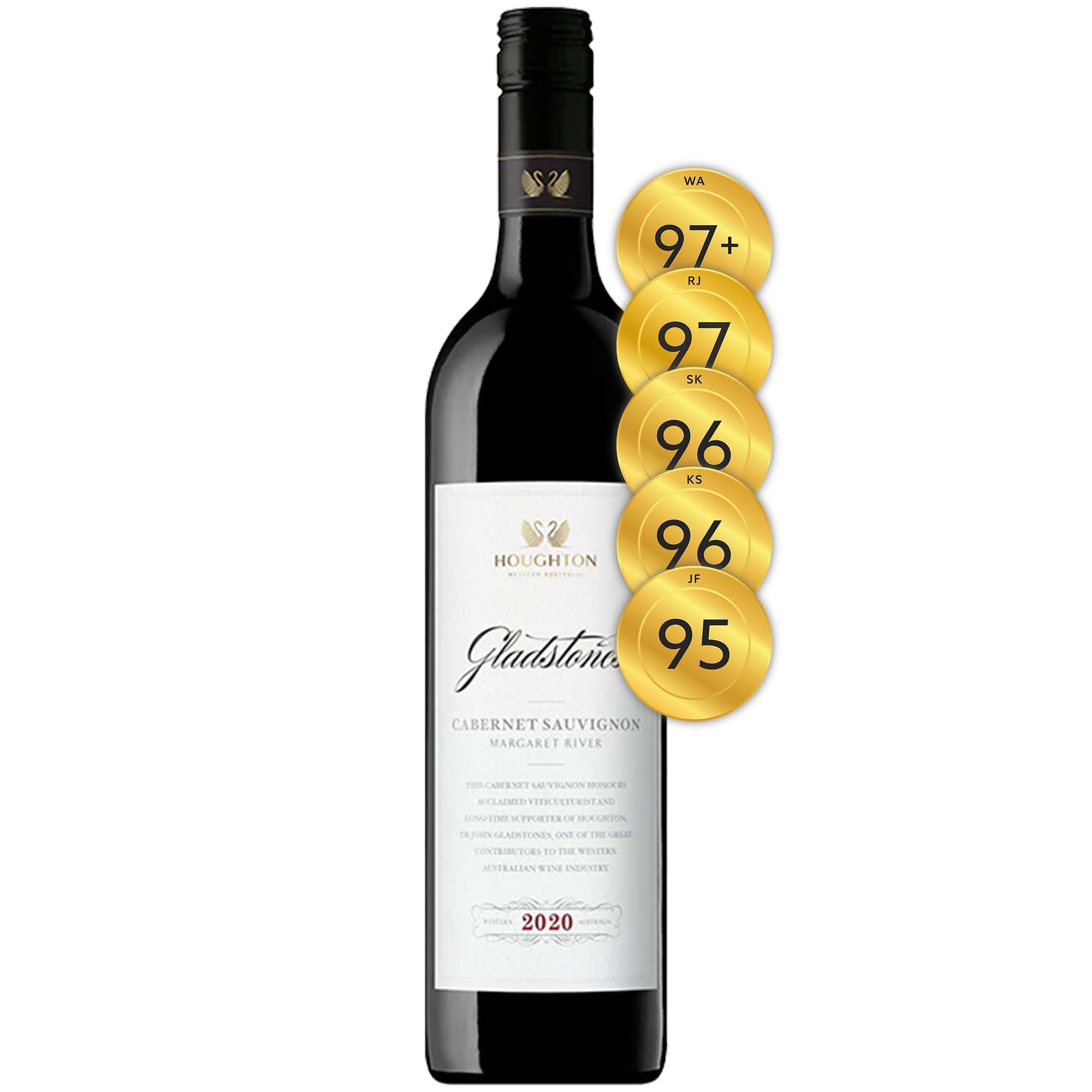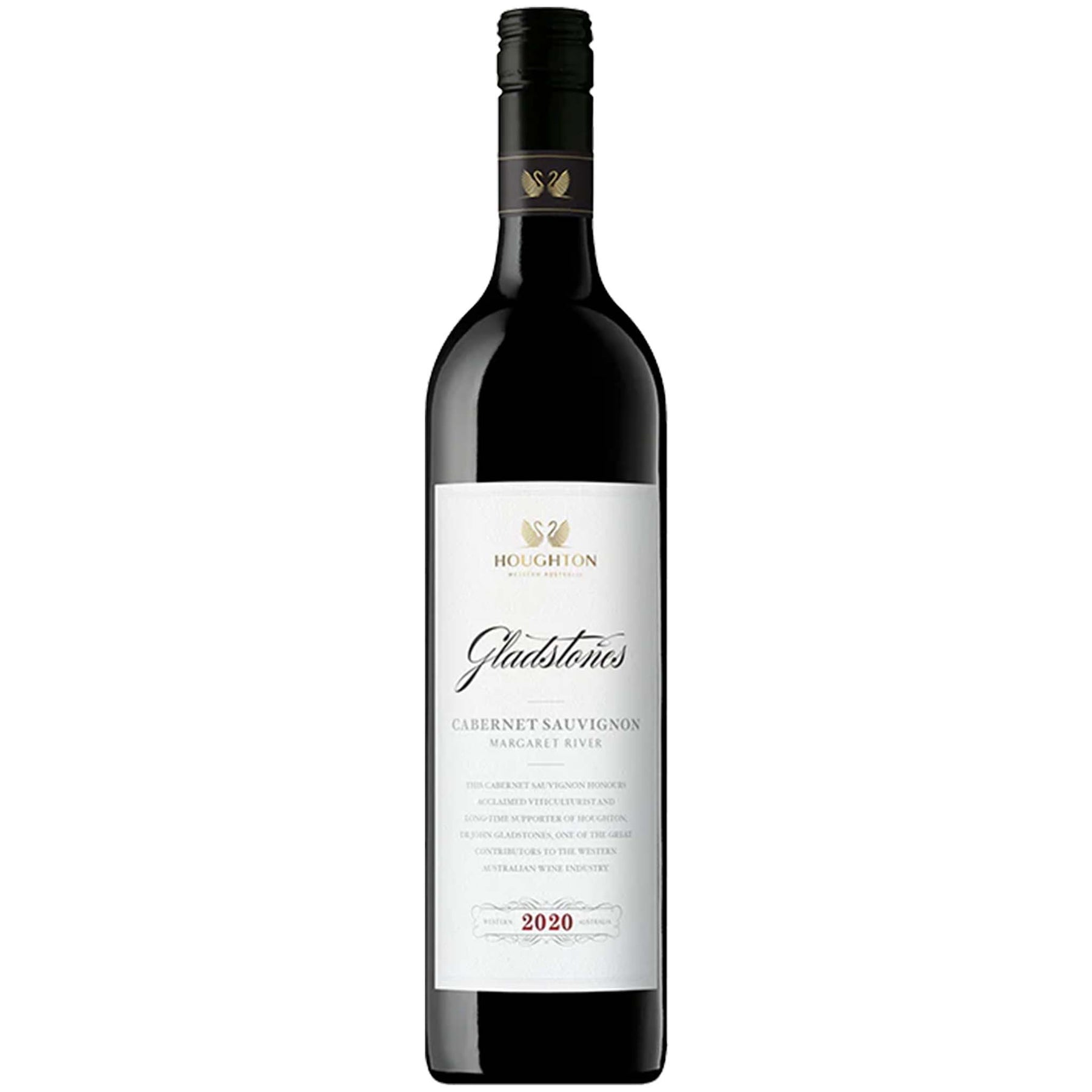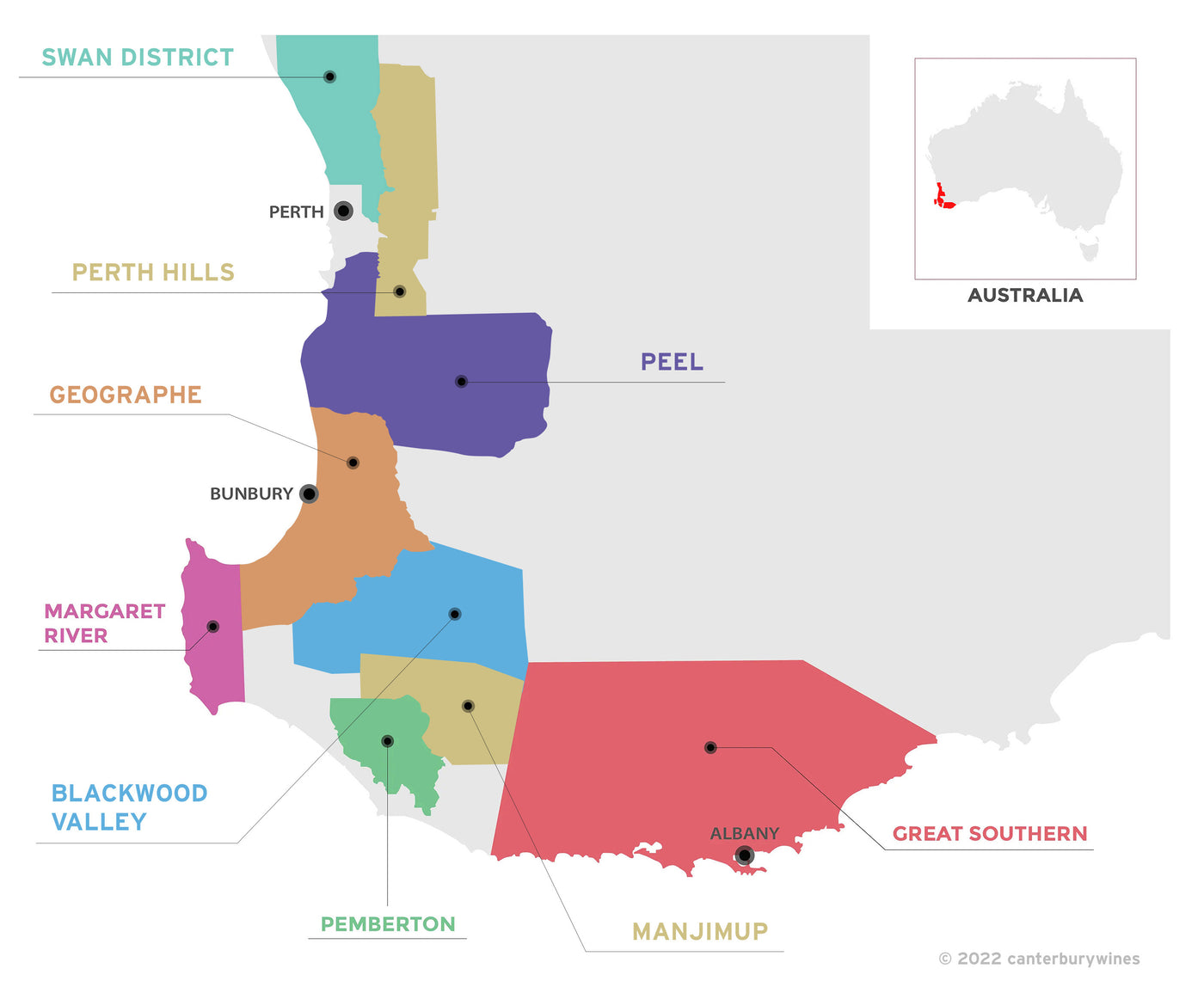

Houghton Gladstones Cabernet Sauvignon 2020
Style: Red Wine
Closure: Screwcap
Houghton Gladstones Cabernet Sauvignon 2020
Warehouse
34 Redland Drive
Vermont VIC 3133
Australia
Critic Score: 97
Alcohol: 13.5%
Size: 750 ml
Drink by: 2045
Houghton, founded in 1836, is one of Australia's oldest operating wineries and Western Australia’s second oldest producer. The Houghton Gladstones Cabernet Sauvignon honours renowned viticulturist and long-time supporter of Houghton, Dr John Gladstones. Fruit was sourced primarily from the Batley vineyard in the Wilyabrup subregion of Margaret River. The wine was matured for 15 months in new, 1 year old and seasoned French oak barriques.
"The Gladstones Cabernet is always an impressive wine on release and ages slowly, like all good Margaret River Cabernet Sauvignons. This 2020 Gladstones Cabernet Sauvignon is prettier and more red-fruited than previous releases. It is all about pomegranate, pink peppercorns, cassis, tobacco leaf, saltbush, bay leaf and nori. This might be one of the greatest Gladstones on release that I have tried. Bravo Treacher, bravo." Erin Larkin
"This wine has a dark red appearance with a scarlet hue. The bouquet is intense with distinct characteristics of the Batley vineyard. Aromas of cassis, plum and milk chocolate combine with bay leaf, thyme and cigar box notes. French oak maturation enhances the complex bouquet with vanillin, pastry and subtle spice. The palate is full bodied and highly structured. This wine shows classic varietal characters of cassis, dark berry fruits and tobacco. The palate is fruit driven with fine firm tannins. The French oak maturation brings complexity, texture and length to the wine." HoughtonExpert reviews
"The Gladstones Cabernet is always an impressive wine on release and ages slowly, like all good Margaret River Cabernet Sauvignons. Unfortunately, we, the drinkers, will not get the opportunity to taste any museum stock from Houghton, due to a tragic warehouse fire in 2019 that destroyed the vinous history of the house. So, to say that this 2020 Gladstones Cabernet Sauvignon is prettier and more red-fruited than the previous releases will only be provable by tastings that you conduct in the privacy of your own home. Suffice to say, this is all about pomegranate, pink peppercorns, cassis, tobacco leaf, saltbush, bay leaf and nori. This might be one of the greatest Gladstones on release that I have tried. Bravo Treacher, bravo. Drink: 2022-2042." Erin Larkin, Wine Advocate - 97+ points
"A wine that pays homage to Dr John Gladstones, whose work was largely responsible for the development of Margaret River. This is right up there with any that have been made, coming from a vintage that was well suited to the variety. Leafy blackcurrant fruit with a graphite oyster shell nuance working with a sliver of black olive. It's a substantial and powerful wine. A fitting tribute, yet there is elegance and poise that stems from the clever balance of fruit, oak and tannin. Drink: 2023-2043." Ray Jordan, Wine Pilot – 97 points
"I expected a wine that would storm the palate, rip the gums off and take no hostages. I was wrong. So much grace in this wine. Elegance speaks through the flavours and structure. Lots of red fruit character and a lightness of being. First, sundried tomatoes with that herbal but sweet note. Then redcurrant, pomegranate, raspberry, black plum. Tobacco and dried peppermint set the tone on top of the bright, tangy fruit. There’s an oyster shell, a mineral type of overtone, that sort of salty-umami tension pitched higher than the peppermint note. Tannins. Fine, tight and cool with a graphite/stoney aftertaste. Acidity. Succulent and bright, the same you get in the aforementioned tomatoes once you chew through the concentrated flesh. Oak. Almost invisible, cedar, light char and cumin in aromas. Flavours vibrate in the back, composing a long-lasting finish. It’s a wine I spent some time with and so should you. Don’t rush it; it unfolds slowly and gracefully. So ready to enjoy now. A very pure and elegant one, the Gladstones. Drink: 2025-2035+." Kasia Sobiesiak, The Wine Front – 96 points
"Deep to opaque core into a ruby red rim. Blackberry, tomato leaf and dusty earth aromatics. The fruit power is remarkable from entry to end, whilst the leafy aromatics were noted the palate is still very much about that glistening ripe fruit. Hints of graphite and tomato lift out over time and the supple tannins are both silky yet powerful, ensuring great length, persistence and clarity. A full-bodied style that encapsulates what Margaret River cabernet can be. Drink: 2023–2043." Stuart Knox, The Real Review - 96 points
"This is elegance personified. So smooth, so luscious, so rich and yet it finds levity and a sense of drive. Inky cassis, lavender and violet floral lift, fancy feeling mahogany and new leather elements, clove spice, bay leaf and faint sea spray characters in the mix. It feels quite tightly wound despite its velvety suppleness and flow, tannins in a web of fine, graphite-like mineral accents delivering tension and poise. It's a wine that delivers an experience and visceral pleasure. Drink now after a lusty decant, but save some for long cellaring, too. Drink: 2025-2045." Jane Faulkner, Halliday Wine Companion - 95 points
Jack Mann

Jack Mann is the finest Cabernet produced by Houghton. It is named after legendary winemaker Jack Mann, who presided over the winemaking for 51 consecutive vintages at Houghton. A pioneer deserves to be remembered for taking bold risks to achieve extraordinary outcomes. Jack Mann typified this from the moment he joined the fledgling Houghton winery in Western Australia in 1922.
Mann’s legacy through 51 years as head winemaker at Houghton, until his retirement in 1974, was profound. Having been instrumental in introducing new winemaking techniques and original wine styles – using Chenin Blanc as the foundation for the incredibly popular Houghton White Burgundy (now called White Classic) – Mann succeeded in making the winery world-famous.
His achievements were honoured in 1994, when Houghton named its icon red wine, made from Cabernet Sauvignon, in honour of Jack Mann. Fruit is sourced exclusively from a small patch of 46-year-old vines on the Justin Vineyard in the Frankland River sub-region of Great Southern. The vines were planted in 1971 and are descendants of the mysterious original Houghton clone selected by Mann himself. Located on ancient granite gravels and enjoying a mild climate, these vines produce fruit of rare quality.
"When you drink the Houghton Jack Mann reds, sourced solely from Western Australia’s Great Southern region, you taste significant fruit power matched to a dusty, stretching, stalker-like length. It’s a great tribute to the bloke who was Jack Mann. He used to travel from the Swan Valley to Great Southern to play cricket, and between sending down leg-cutters he’d salivate at the wine potential of the place.
He spent 51 consecutive years as winemaker at Houghton’s home base in the Swan Valley, and in the process he put his state on the winemaking map – to the enduring benefit of the wine-loving world. He also had a saying: 'The greatest grape is the noble cabernet. Cabernet sauvignon is the only grape that would be tolerated in heaven.'
The Houghton Jack Mann Cabernet Sauvignon, which he never got to taste, was first produced from the 1994 vintage, and was made by Paul Lapsley. Jack Mann himself died in 1989. His name adorns a wine whose pedigree is largely, shamefully, ignored: it is a single vineyard wine produced off vines planted at the dawn of Western Australian wine time – in the late 1960s and early 1970s. It is hand-picked, hand-made, fussed over and thought through. It’s fermented in small batches. Most years it achieves excellent ripeness, and with the strength of its various varietal components has an edge of complexity over most other Australian cabernets. The vineyard from which it comes is in the Frankland River area of Great Southern. Like Bordeaux, it is a maritime-influenced region.
Frankland is the driest sub-region of the Great Southern region. It is 220 metres above sea-level, and in this dry, ocean-cooled heat the vines strain down into a mix of light medium clay soils and sandy loams. The vineyard block itself is of significant size – it’s nearly 90 hectares. It runs upwards, along a ridge, and the grapes that make it into the Jack Mann cabernet invariably come from the vines planted at or near the top of that ridge – where the soils are skinny and hard. The vineyard is essentially dry grown, though limited water is available should the vines show undue stress – or look as though they are in danger of death. Salinity, of the area’s water and the area’s land, is a significant mitigating factor both to future development and to the way existing vineyards are worked.
Winemaker Paul Lapsley now admits that the 1994, 1995 and 1996 wines were blatantly made to win awards at wine shows. 'In 1994, our five-year plan was to try to put Houghton on the map as a red wine producer, because up until then it was known pretty much only as a white wine producer. It was calculated then that we’d produce the first three vintages in a concentrated show style to make a statement.'
This is all fine, dandy, and unexceptional – except that the 1994, as a ten year old, has outgrown its bulk, its breadth now outdone by its length. It also tastes as though it has another ten years up its sleeve. The belief now is that, within reason, the quality of the grapes grown on this mature, Frankland River vineyard are of such exceptional quality that they will out-stay whatever winemaking quirks are thrown at them. It’s why the general belief now is that, if the 'Jack Mann' grapes were human, they would make for a great lover … they have staying power." Campbell Mattinson
About the winery

Houghton is one of Australia's oldest operating wineries and Western Australia’s second oldest producer. In 1836, only four years after the fledgling town of Perth was established, three British Army officers purchased a prime piece of land in the Swan Valley and established Houghton.
Thomas Yule had retired from the Army to settle in Perth and convinced mates Ninian Lowis and Richmond Houghton to join him in an investment in the Swan Valley. In deference to Houghton's seniority as a Lieutenant Colonel they named their property Houghton - but interestingly Houghton himself never visited Australia, and although Lowis called into Fremantle on his way to the eastern colonies, he too never bothered visiting his Swan Valley investment.
Yule established fruit orchards and planted grapes for making into raisins, and also made his own wine for regular dinner parties. However, he fell on personal hard times in the mid-1850s and sold his interest in Houghton to his partners, who in turn sold out in 1859 to the Colonial Surgeon, Dr John Ferguson.
The highly-regarded Ferguson, a Scot who reputedly was the first person in Australia to use anaesthetic, had a scientific interest in winemaking and in his first year at Houghton used Yule's grapes and winemaking equipment to produce the property's first commercial wine. The wines sold well in Perth, prompting John to buy an adjoining property and appoint his son Charles to manage the property. By 1866, the Fergusons had 6ha under vines.
Charles Ferguson took over the full company reins in 1875. Interestingly, he developed a business relationship with a winemaker in South Australia named Thomas Hardy who had founded Thomas Hardy & Sons, and who acquired some of Charles' raisins. Little would Charles have foreseen that 83 years later, Thomas Hardy & Sons would become the owners of his Houghton property.
By the early 1900s, Houghton wines were so successful that in 1920 Charles turned the property over to his own sons John and Donald, with George Mann as chief winemaker. George Mann in turn trained his son Jack as a winemaker, the son inheriting the Chief Winemaker mantle from his father in 1930. Seven years later, Jack Mann experimented with a wine using entirely Chenin Blanc grapes, the wine winning 'Best Dry White Table Wine' trophy at the 1937 Royal Melbourne Wine Show. One judge likened it to "the great white Burgundies of France" and the company labelled it Houghton White Burgundy.
Jack Mann was 31 when he made the White Burgundy and became the winery's driving force with 51 consecutive vintages at the helm. It became the biggest selling white wine nationally and during this period over half the grapes crushed in Western Australia went into Houghton White Burgundy. In 2006, the wine was relabelled Houghton White Classic to comply with international regulations.
Houghton was bought by the Emu Wine Company in 1950, saw its 1-millionth bottle of White Burgundy produced in 1972, and in 1976 the Emu Wine Company was in turn acquired by Thomas Hardy & Sons. In 2011, Accolade Wines acquired Houghton after several corporate mergers and acquisitions.
Houghton gradually eased itself out of its original home, the Swan Valley, and has not produced Swan Valley table wines for many years. It expanded into the South West and Great Southern regions and established a winery at Nannup in the Blackwood Valley in 2003. Houghton's portfolio now features a range of high-quality wines from Frankland River, Mount Barker, Pemberton and Margaret River. The winery operates four of Western Australia's largest vineyards at Pemberton (92ha), Mount Barker (74ha), Frankland River (89ha) and Moondah Brook (145ha) which is located some 88km north of Perth in the foothills of the Darling Ranges in the Swan District region.
Today Houghton is under the umbrella of Accolade Wines. In 2019, much to the horror of many in the Australian wine industry, Accolade decided to sell the historic Houghton winery and cellar door in the Swan Valley. Houghton moved its entire wine production to its base in Nannup ending a winemaking era that began in the Swan Valley almost 200 years ago.
The move was strategic as Nannup is halfway between Margaret River and Frankland River, the two areas from which Houghton sources most of its grapes. Now, all of the wines are fermented and completed at the winery in Nannup. The resulting wines are produced with the same consistency of style, whether it be the beloved Houghton White Classic or a beautifully complex icon wine such as a Gladstones Margaret River Cabernet Sauvignon.
Houghton's new cellar door is located in the Margaret River, which they share with Brookland Valley (also owned by Accolade).
Winemakers

In its 188-year history, Houghton Wines has had just fourteen Senior Winemakers. Courtney Treacher was appointed to the position in 2020, following the departure of long-serving winemaker Ross Pamment who worked for Houghton for 21 years, the last 10 as Senior Winemaker.
Pamment was responsible for multiple award-winning wines and was named Winemaker of the Year in Ray Jordan’s 17th Annual West Australian Wine Guide in 2017. He oversaw the full range of Houghton wines, from the definitive, consistent style of Houghton White Classic (formerly Houghton White Burgundy) to small parcels of fine wines, including Jack Mann Cabernet Sauvignon, Gladstones Cabernet Sauvignon, Thomas Yule Shiraz and C.W. Fergusson Cabernet Malbec.
Continuity was assured when Courtney Treacher was appointed Senior Winemaker as she had worked with Pamment for 17 vintages. "I joined Houghton in 2004 as a cellar hand and never left. It’s an honour to continue the Houghton philosophy and style of winemaking, which is to do most of the work in the vineyard and focus on quality fruit selection. It is then for the winemakers to carefully nurture the wines through their maturation, blending and fining through to bottle," she says, adding that "I have no grand plans for change, but there may be some minor finessing around oak selection, for example. We aim to provide a pure version of the fruit and vintage each year with minimal winemaking intervention. We may finesse around the edges but only to continue increasing the quality of wines produced at Houghton."
Courtney has also judged at many local and national wine shows and was a scholar at the prestigious Len Evans Tutorial in 2011 - an experience she describes as once in a lifetime.

Western Australia
Western Australia is home to more than 400 wineries across nine vast and extraordinary wine regions which are almost entirely concentrated in the south-west and great southern land divisions of the State. The regions are Blackwood Valley, Geographe, Great Southern, Peel, Pemberton, Manjimup, Margaret River and Swan District.
The oldest region is the Swan Valley, the best known both nationally and internationally is Margaret River and the largest is Great Southern. The Great Southern region is further divided into the five subregions of Albany, Denmark, Frankland River, Mount Barker and Porongurup.
The history of wine production in Western Australia dates back to 1840 with the establishment of Sandalford in the Swan Valley region. The recognition of the fine wine possibilities started to be realised after the establishment of the Margaret River Region in 1967, which has become renowned for its high quality Chardonnay and Cabernet Sauvignon. The other regions produce a diverse range of regionally distinct wines, from stunning Rieslings and evocative Shiraz, to a range of unique Cabernet Sauvignon blends.

